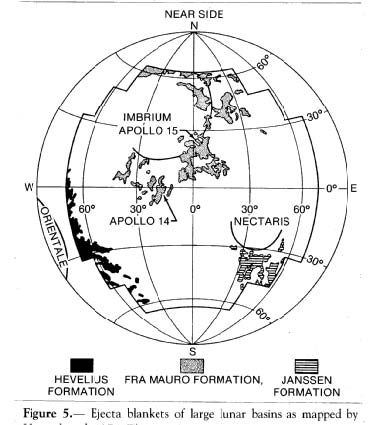Sampling the Moon
First it was important to obtain both mare and highland materials. The Apollo 11, 12, 15, and 17 sites and the Luna 16 and 24 sites were all on lunar Maria. Apollo 15 and 17 were carefully placed next to the highlands. The Apollo 16 and Luna 20 sites were selected specifically to be entirely on the highlands.
Figure 4 is a profile of the Al/Si ratios across the Maria and highlands obtained by the X-ray experiments onboard the Apollo 15 and 16 command and service modules. The highland regions were very Al rich. Results from these orbiting experiments were entirely consistent with samples returned from areas under these groundtracks.
The frontside of the Moon (fig. 5) has several large basins formed by giant cratering events (Imbrium, Serenitatis, Crisium, Nectaris, etc.). The Orientale basin (fig. 6) situated on the left limb of the Moon is the best preserved of these giant impact structures. Radial deposits of ejecta can be seen extending great distances beyond the outer rim of the crater (Hevelius Formation). This observation was extended to the radial deposits of the Imbrium basin (the Fra Mauro Formation) in order to devise a strategy for sampling the interior of the Moon. The Apollo 14 and 15 sites were picked to give two different radial samples of Imbrium ejecta and, thus, samples from two different depths in the lunar crust. The results of this sampling strategy are confusing. All the material brought back from Apollo 14 was breccia (similar to sample 14305 included in this study set) indicating that we were successful in obtaining samples of the Fra Mauro Formation at this site. At the Apollo l5 site, rare noritic breccias (samples 15445 and 15455) were found that may have come from deep within the Imbrium target. However, the relationship of the samples collected at the Apollo 16 and 17 sites to ejecta collected from large basins is not known.
Currently, scientists are planning a mission to sample the even larger crater (SP-A) discovered on the backside of the Moon (Taylor 1998).
Figure 4. Al/Si ratios of the lunar Maria and highlands as obtained by the orbiting X-ray fluorescence experiment onboard the Apollo 15 and 16 command and service modules. Solar radiation excites X-rays from light elements (Mg, Al, and Si) that were counted by the X-ray spectrometer as it orbited the Moon. Ratios were normalized to “ground truth” obtained from soil samples returned from landing sites overflown by the experiment. Only the sunlit side of the Moon could be measured, but the highlands were always high Al.

Figure 5. Ejecta blankets of large lunar basins as mapped by Howard et al. 1974. The Hevelius Formation, extending out from Orientale, served as a model for photointerpretation of the older Imbrium deposits. The Fra Mauro Formation, extending outward as radial deposits from Imbrium, was sampled by Apollo 14 and 15.
Figure 6. The giant Orientale basin is the most recent of the large impact craters on the Moon. It is as large as Texas! This photo of the eastern limb of the Moon was taken by Lunar Orbiter. Orientale ejecta may have been spread all over the Moon but it has not been recognized in the lunar samples that have been returned.


